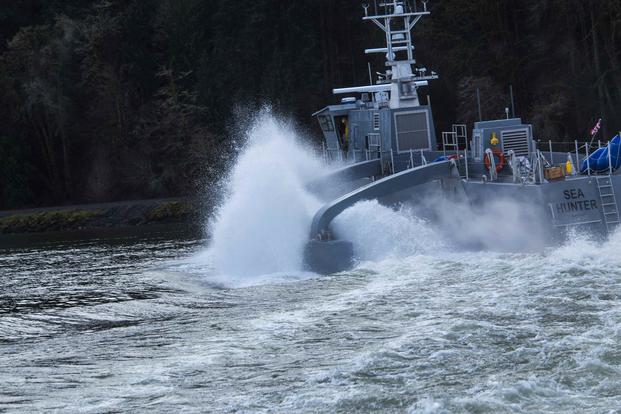Some in Congress remain unconvinced the Navy knows what it wants out of its fleet of large unmanned surface vessels, and they're moving to block funding for more big drone ships until the service lays out a plan.
Members of the House Armed Services Subcommittee on Seapower and Projection Forces included a section in their 2021 National Defense Authorization legislation proposals that would "prohibit the procurement of any large unmanned surface vessels in fiscal year 2021 until a certification regarding technology maturity has been submitted to Congress."
Read Next: US Forces Korea Announces Survey to Name New Campaign Against Racism
The Navy planned to buy two more large unmanned surface vessels in 2021. The service wants $2 billion to build 10 large unmanned surface vessels, or LUSVs, by 2025.
The Defense Department has been testing a pair of unmanned surface vessels, and the Navy has two more under construction.
But the congressional subcommittee says funds should be freed up for more large unmanned surface vessels in 2021 only if the Navy certifies hull, mechanical and electrical systems for its future planforms and proves they can operate autonomously for at least 30 days, the text states.
A committee aide told reporters that lawmakers recommended against giving the Navy money to buy more large unmanned surface vessels because they don't want a repeat of the littoral combat ship program, which saw a host of problems.
"If you look at their acquisition strategy, there's really no gap between what they're calling these prototype ships and when they go into actual serial production," the aide said of the new large unmanned surface vessels. "So essentially, they've been trying to go into serial production from the very beginning.
"We don't believe that's a sound strategy."
Rear Adm. Casey Moton, program executive officer for unmanned and small combatants, hit back against that idea Tuesday. The Navy isn't planning to buy its first program-of-record LUSV until 2023, he said, when "everything is matured."
"[That vessel] is going to be quite a bit different from the prototypes," Moton said during an event hosted by the U.S. Naval Institute and Center for Strategic and International Studies. "I think there are folks out there that believe our prototypes are the start of a serial production run. I don't believe that's true."
Moton also said he believes the Navy can meet the threshold lawmakers want to see: 30 days of autonomous operations.
This isn't the first time the Navy has faced pushback from lawmakers on Capitol Hill over its plans for a fleet of unmanned surface vessels. Last year, when the service first asked for billions of dollars over the next several years to build large drone ships at the same time leaders wanted to send an aircraft carrier into early retirement, lawmakers on both sides of the aisle balked.
"We're trying to avoid the mistakes that were made on LCS when the original plan was to build four prototypes to test them, figure them out -- and the Navy made the mistake of just continuing to build them," a congressional staffer said last year, echoing some of the same concerns shared this year.
In the bill proposed this week, lawmakers also said they want more clarity on how the Navy's drone ships will be weaponized.
"The Secretary of the Navy may not integrate any offensive weapon system into a large unmanned surface vessel until the date on which the Secretary of the Defense certifies to the congressional defense committees that any large unmanned surface vessel that employs offensive weapons will comply with the law of armed conflict," the bill states. "Such certification shall include a detailed explanation of how such compliance will be achieved."
Moton said Tuesday that the large unmanned surface vessels have berthing spaces, so they can be optionally or lightly manned. And any weapons systems, he added, will be operated by a human -- even if they're not sitting on the vessel.
-- Gina Harkins can be reached at gina.harkins@military.com. Follow her on Twitter @ginaaharkins.
Related: Here's What the Marines Want in the Navy's Fleet of Unmanned Drone Ships












